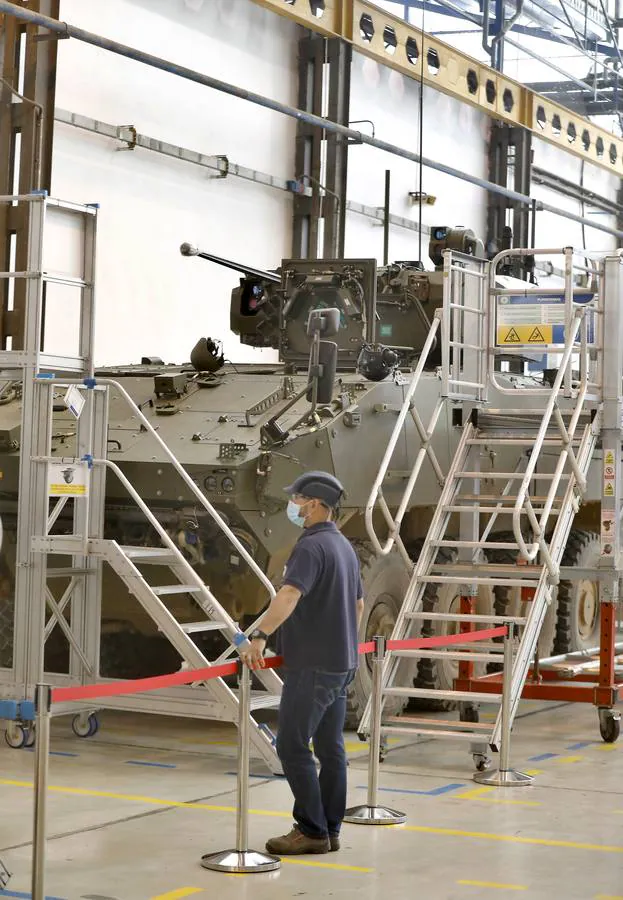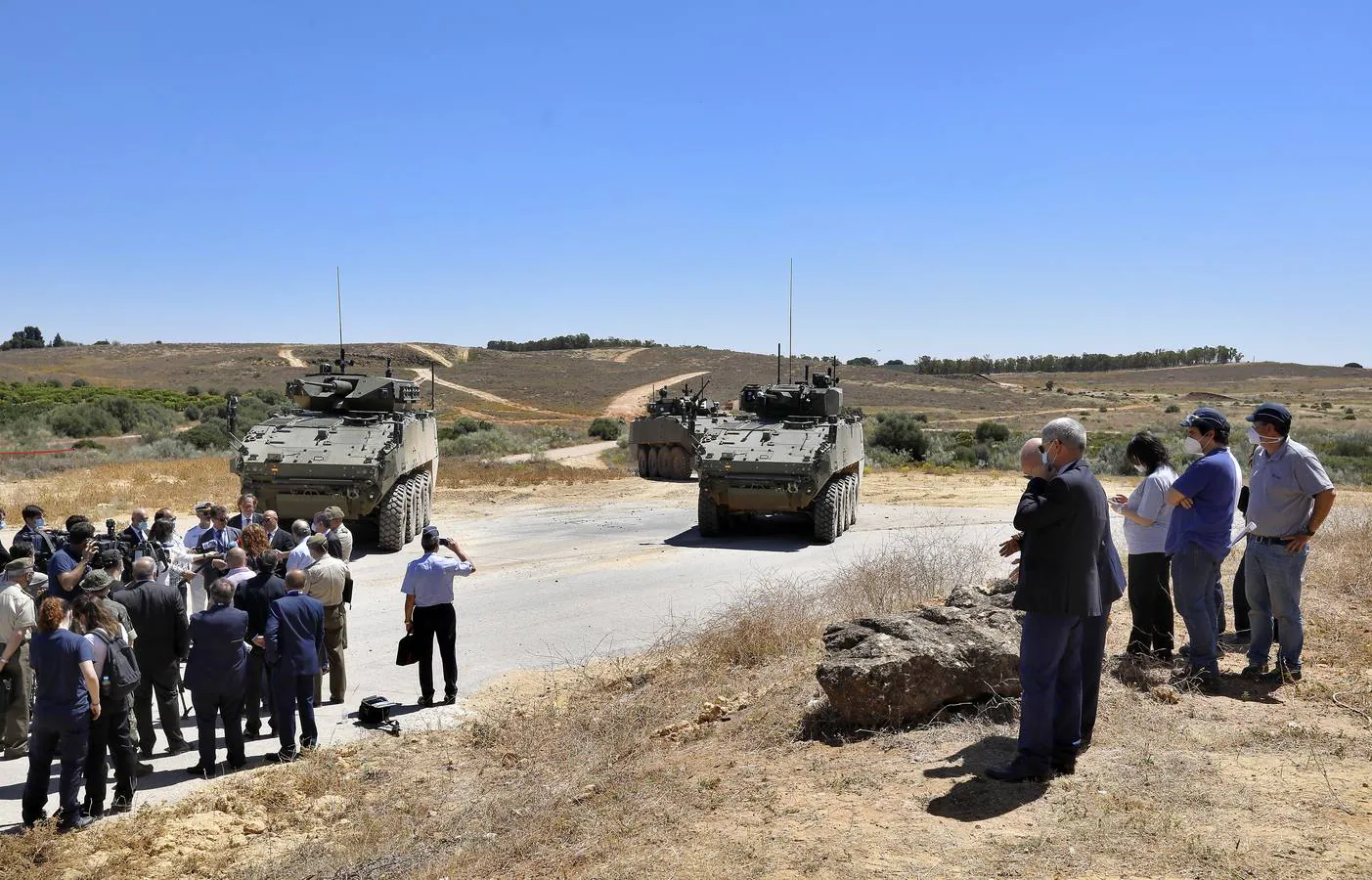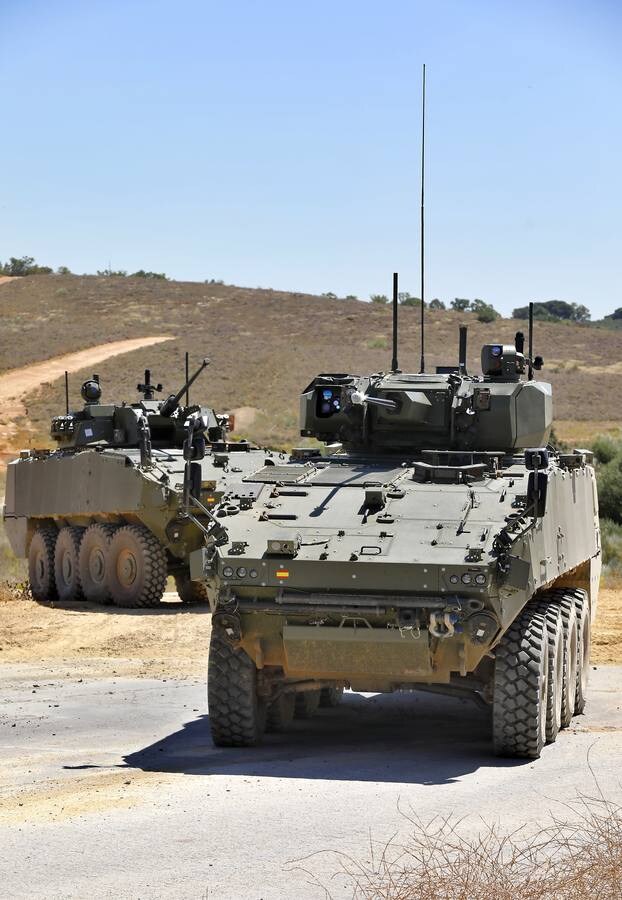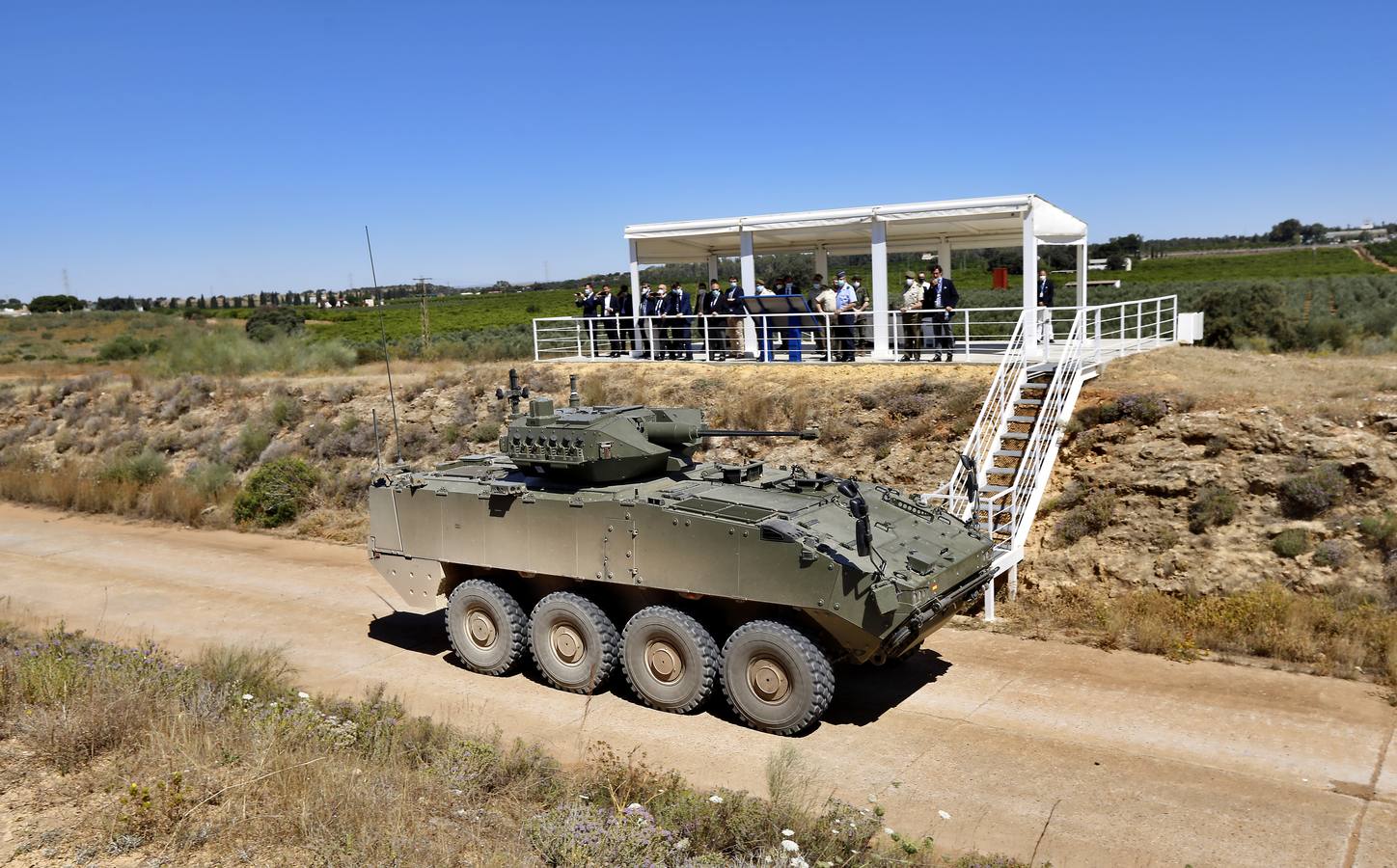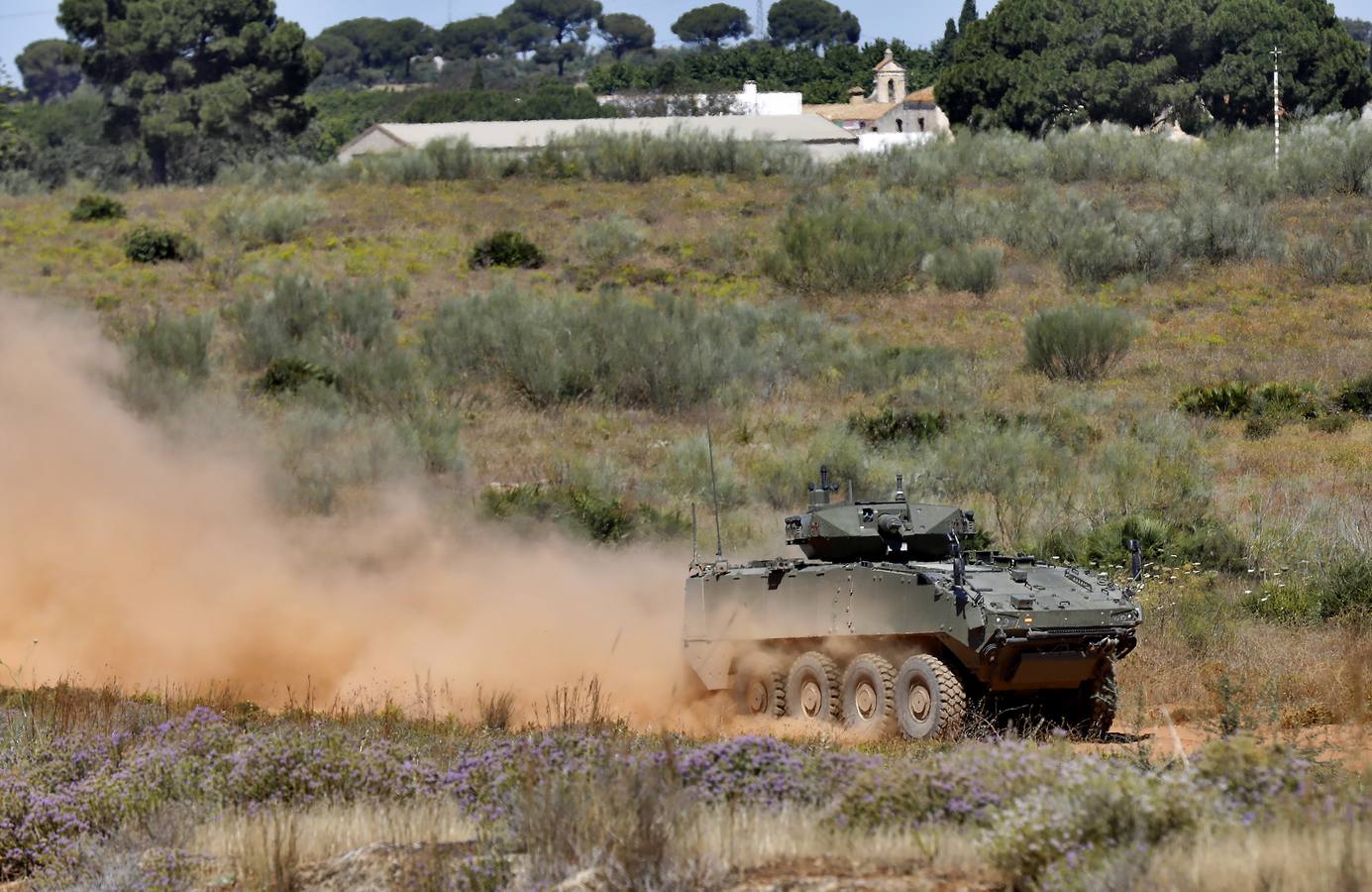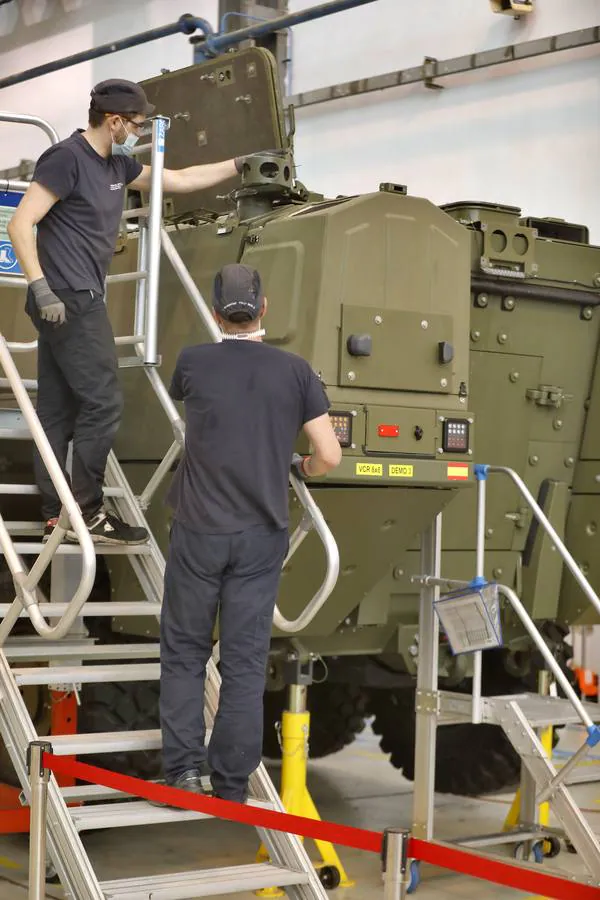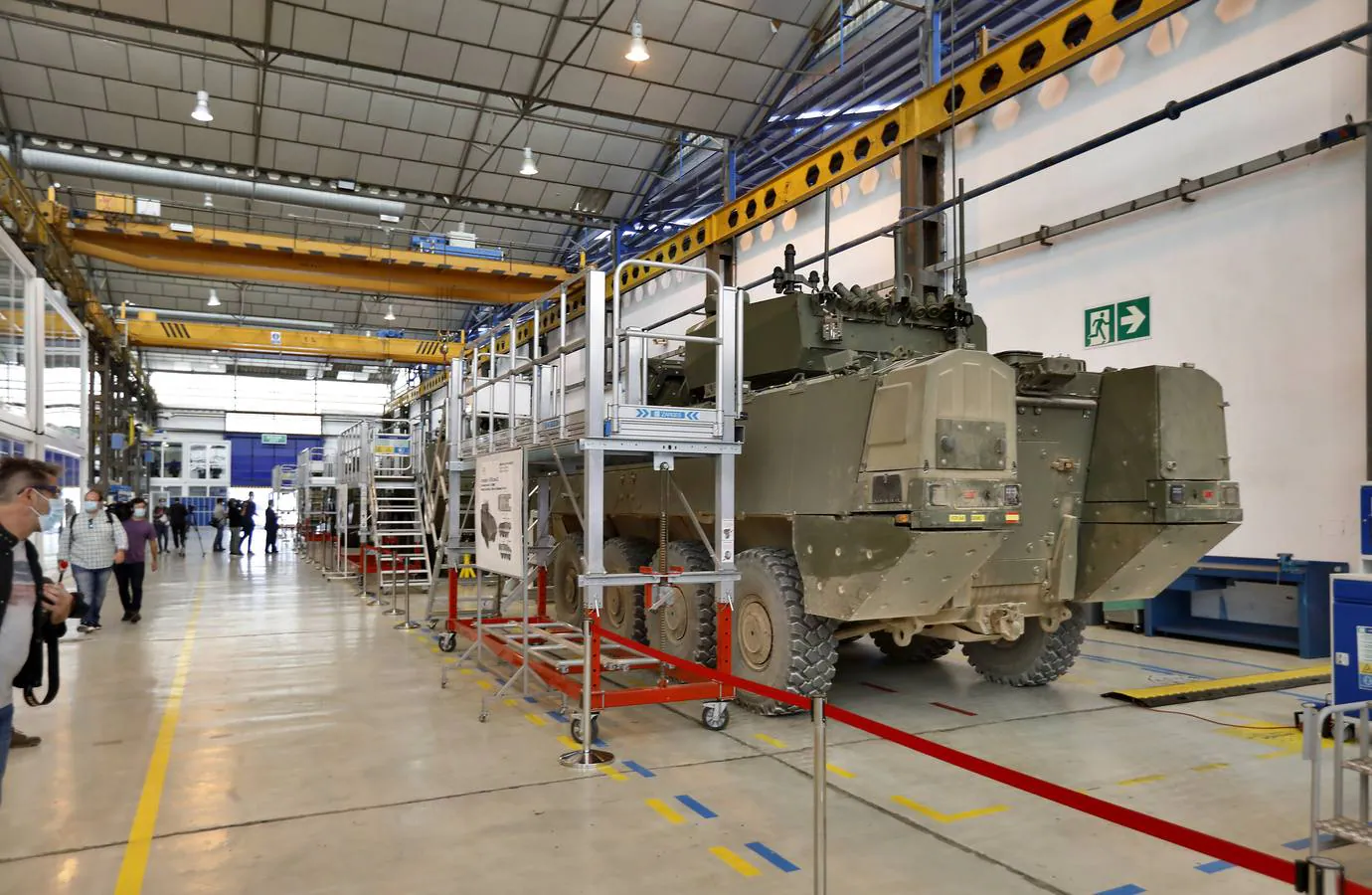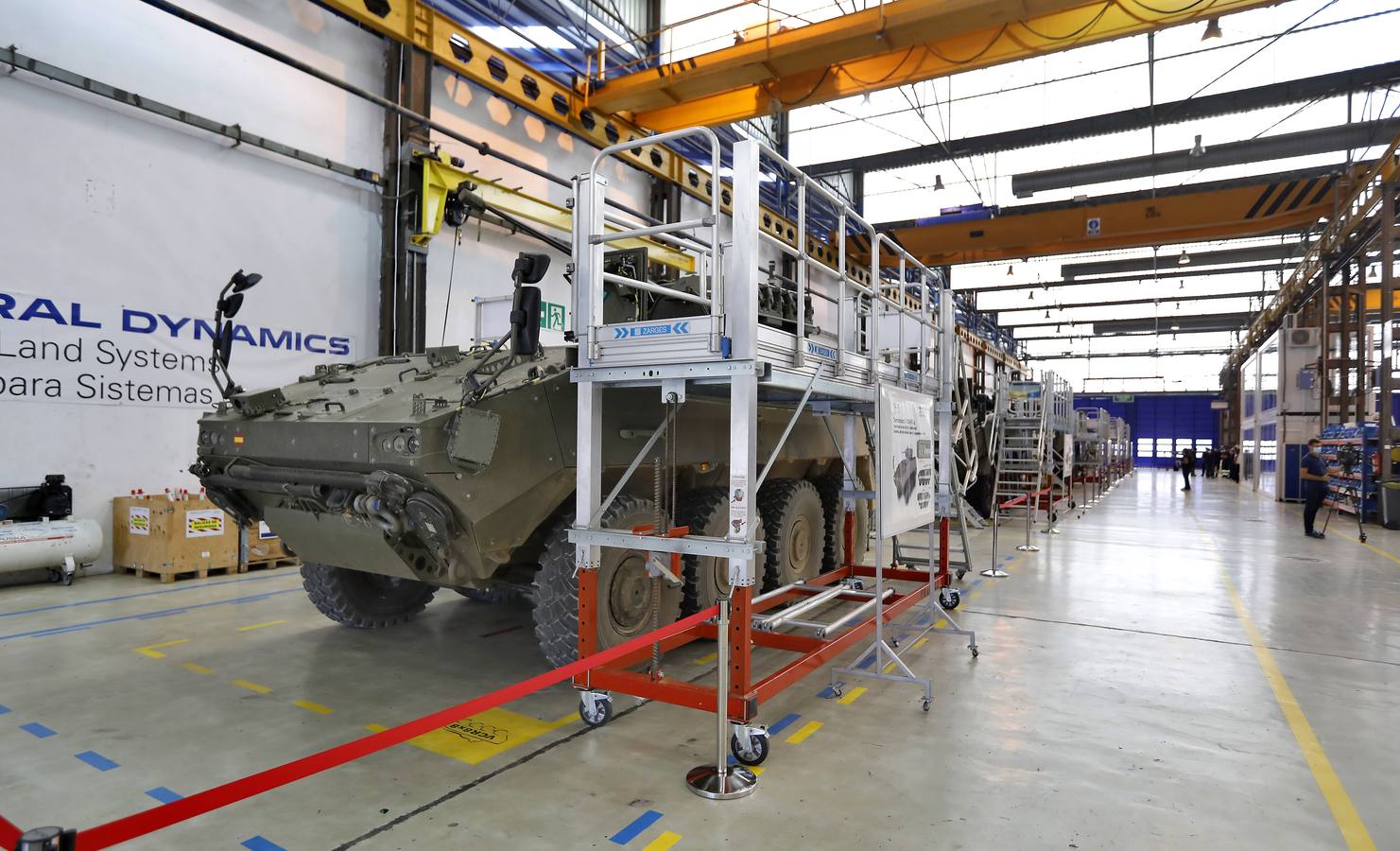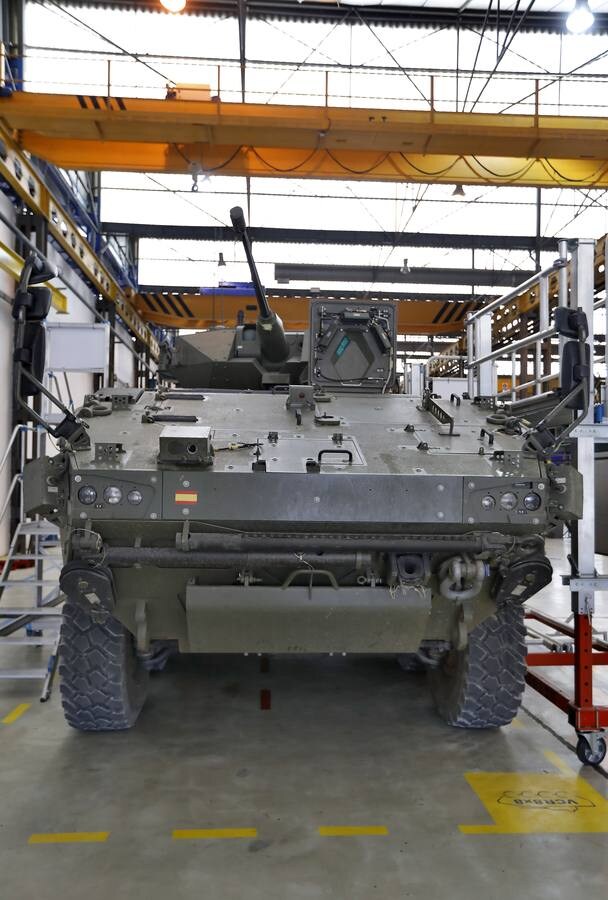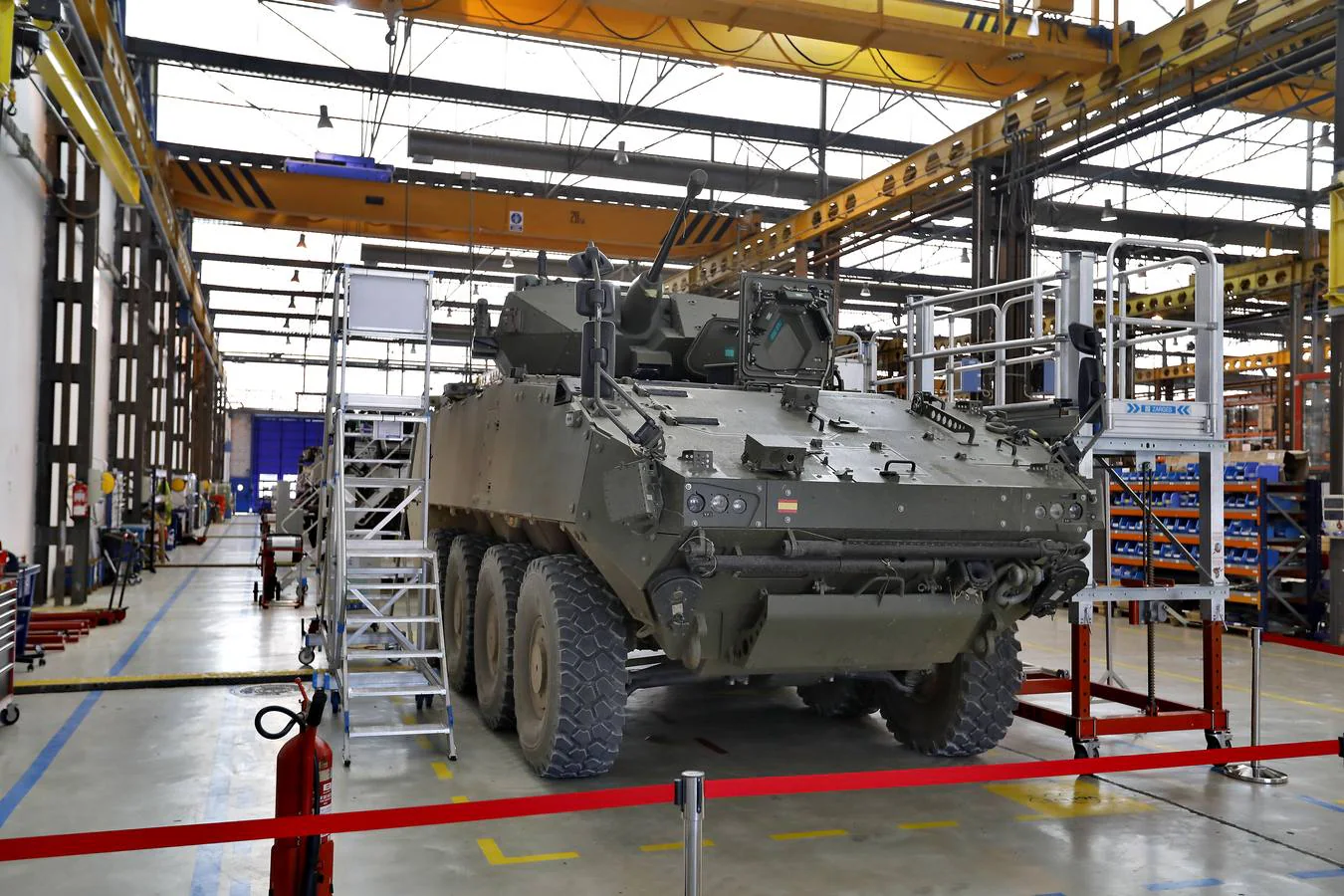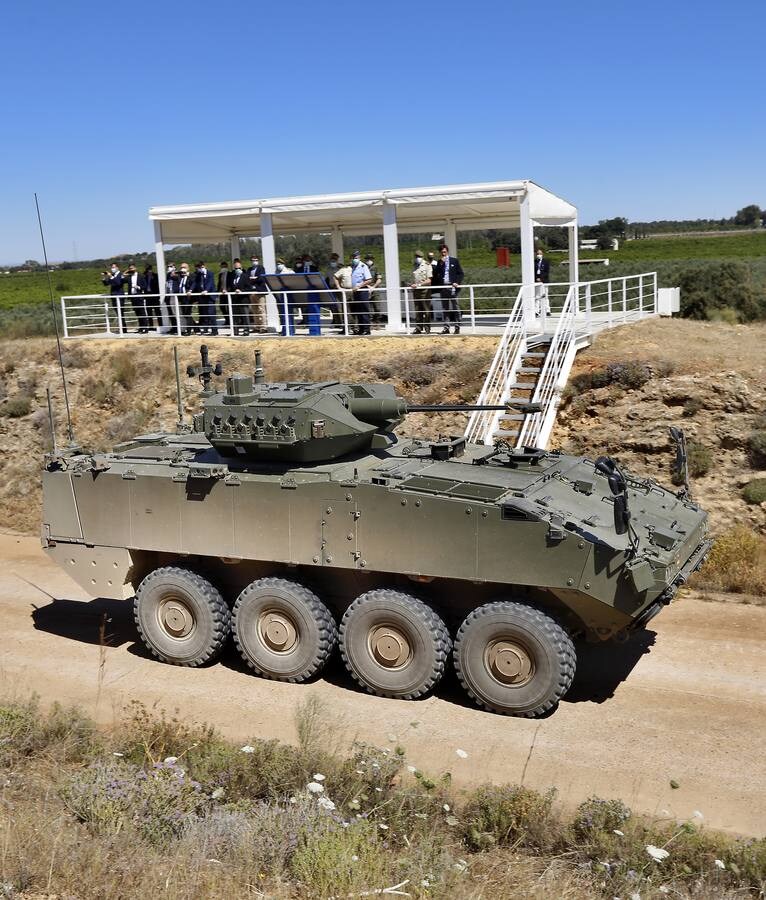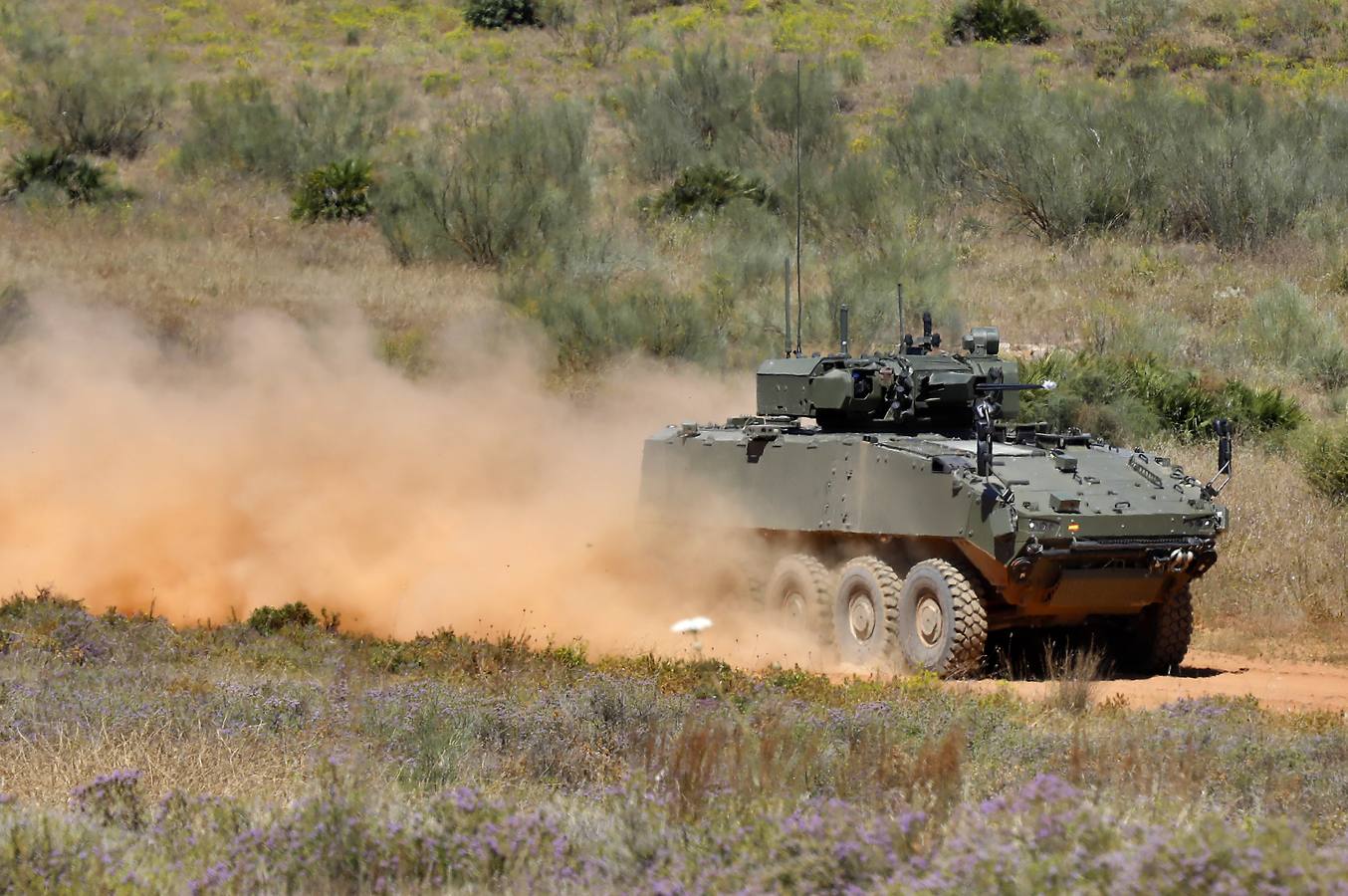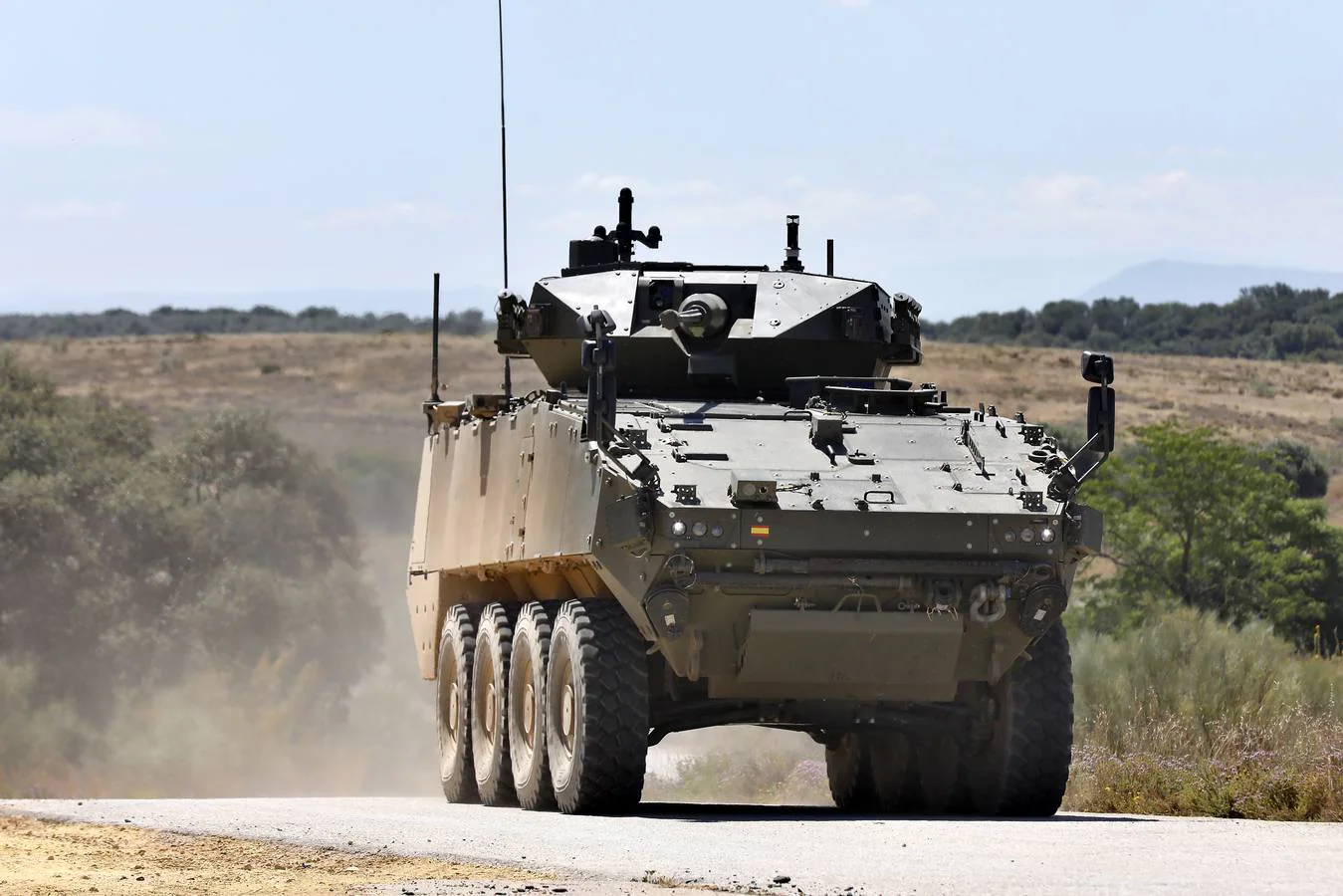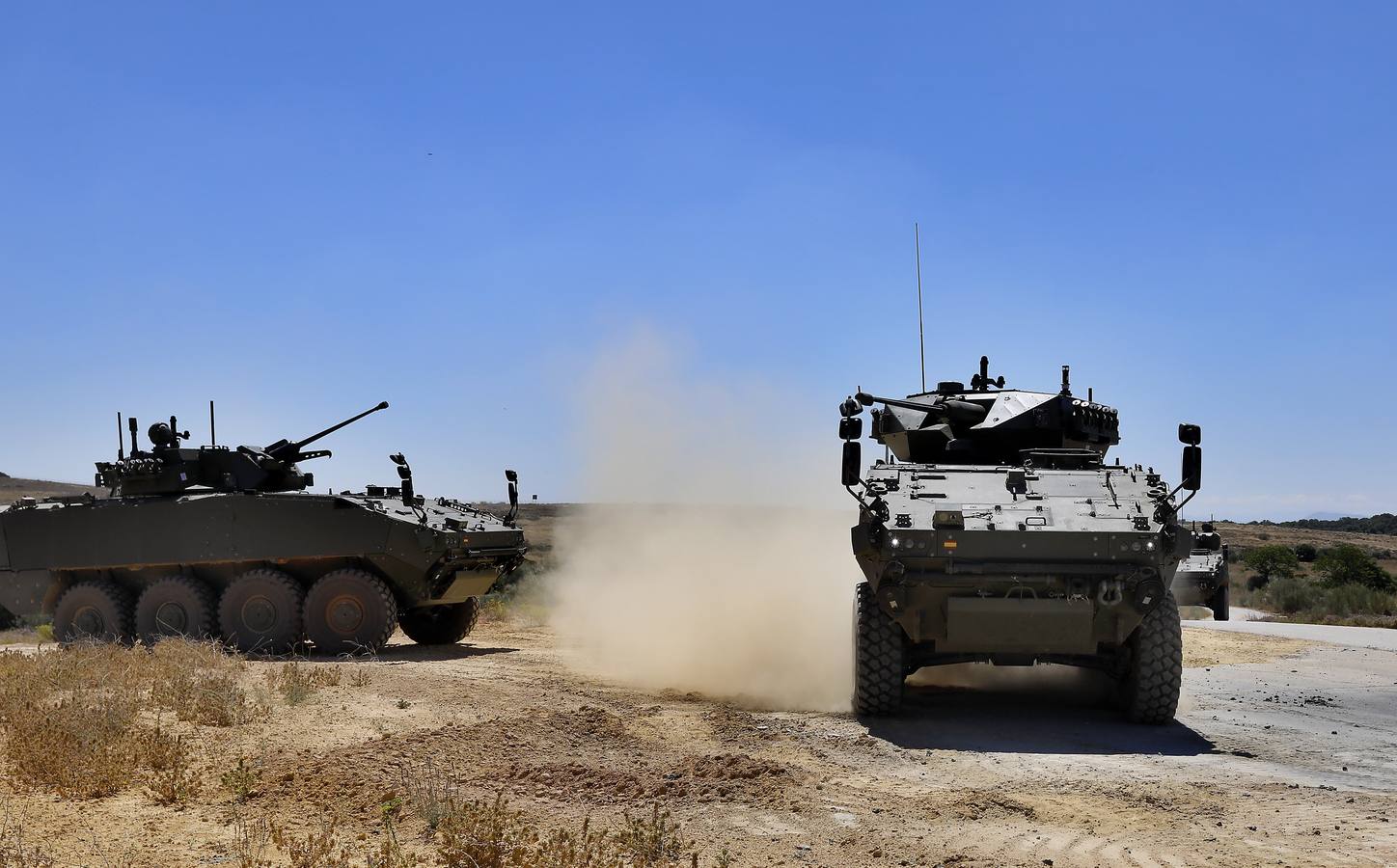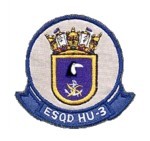goldfinger escreveu:Presentación de los 3 primeros prototipos del DRAGON con sus distintas torres:
En esta semana se van al Campo de San Gregorio en Zaragoza para las pruebas intensivas de fuego de las distintas torres.
tanques e blindados
Moderadores: J.Ricardo, Conselho de Moderação
- cabeça de martelo
- Sênior

- Mensagens: 39448
- Registrado em: Sex Out 21, 2005 10:45 am
- Localização: Portugal
- Agradeceu: 1136 vezes
- Agradeceram: 2843 vezes
Re: tanques e blindados
- eligioep
- Sênior

- Mensagens: 1963
- Registrado em: Qua Fev 27, 2008 4:25 pm
- Agradeceu: 402 vezes
- Agradeceram: 341 vezes
- eligioep
- Sênior

- Mensagens: 1963
- Registrado em: Qua Fev 27, 2008 4:25 pm
- Agradeceu: 402 vezes
- Agradeceram: 341 vezes
Re: tanques e blindados
Saberia dizer qual a diferença entre as torres?cabeça de martelo escreveu: ↑Ter Jun 30, 2020 5:15 am Presentación de los 3 primeros prototipos del DRAGON con sus distintas torres:
- cabeça de martelo
- Sênior

- Mensagens: 39448
- Registrado em: Sex Out 21, 2005 10:45 am
- Localização: Portugal
- Agradeceu: 1136 vezes
- Agradeceram: 2843 vezes
Re: tanques e blindados
Estão a testar 5 torres, 3 de 30mm (duas delas não tripuladas e uma tripulada) e 2 de 12,7mmeligioep escreveu: ↑Ter Jun 30, 2020 10:59 amSaberia dizer qual a diferença entre as torres?cabeça de martelo escreveu: ↑Ter Jun 30, 2020 5:15 am Presentación de los 3 primeros prototipos del DRAGON con sus distintas torres:
As duas de 12,7mm são da espanhola Guardian e a Mini Sampson da Rafael.
As de 30mm são as UT30M da Elbit, a SAMSOM Mk2 e a torre Hitfist da Leonardo a pedido da Cavalaria que quer as suas Viaturas com uma torre tripulada.
- FCarvalho
- Sênior

- Mensagens: 37877
- Registrado em: Sex Mai 02, 2003 6:55 pm
- Localização: Manaus
- Agradeceu: 5704 vezes
- Agradeceram: 3255 vezes
Re: tanques e blindados
Há condições de reforma para preservação do veículo?
Me dá um nó na garganta só de ver ele naquele estado. Me revolta o estômago.
abs
Carpe Diem
- EDSON
- Sênior

- Mensagens: 7303
- Registrado em: Sex Fev 16, 2007 4:12 pm
- Localização: CURITIBA/PR
- Agradeceu: 65 vezes
- Agradeceram: 335 vezes
Re: tanques e blindados
MAIN BATTLE TANK DEVELOPMENT CONCEPT OF GERMAN ARMY (PART 1)
Written by V. Boryushin, V. Sokolenko; Originally appeared at Foreign Military Review #3 2019, translated by AlexD exclusively for SouthFront
In recent years, the leading military and economic powers of NATO have increased their activities in analysing possible directions for the development and use of the combat vehicle arsenal (CVA) of the ground forces in future wars. For this purpose, the experience of combat application of such equipment in past wars is studies and generalised, new tactical methods for conducting CVA combat operations in open terrain and in urban conditions with complex infrastructure, including the joint use of robotic complexes, and various options for the modernisation of armoured combat vehicles (ACVs) are developed.
A characteristic feature of the activities carried out at the present stage is the transition from theoretical research, which was started in certain areas in the 1990s, to the practical implementation of many complex and expensive programmes for the development and modernisation of CVAs. Some of this work has already moved from the field of R&D to the creation of experimental and demonstration models, and in some cases, to serial machines. In the course of research work on CVA samples, modern technologies are being introduced to increase their combat capabilities.
Materials published abroad today on current trends in the development and application of CVAs present a wide range of views, sometimes contradictory, both by the leadership and the military-industrial complex (MIC) of the Alliance countries and individual authors.
For example, some foreign experts identify in these publications the following fundamental provisions that will have a decisive influence on the reforms being carried out of the ground forces and the direction of further improving the combat effectiveness of the CVAs: “in the wars of the future, mass use of tanks is not expected”; but at the same time, it is believed that “mass use of tanks, AIFVs, APCs are not excluded when performing certain tactical tasks, for example, when attacking poorly prepared anti-tank defences”; further, experts say that “large-scale tank battles are no longer intended to play a decisive role for a positive outcome of a ground operation”; “the time of mass tank battles in open terrain has passed, and in the future we should expect the use of tanks mainly in operations in urban conditions.
This will require improvement of both the design of combat vehicles and the tactics of their use”; “the main use of tank units of the ground forces will be time-limited operations, involving rapidly changing ways of conducting combat operations, decisive manoeuvres by forces and means of the modular organisational structure of the military formations in close cooperation with units of other arms and services of the armed forces”.
At present, the above views have not yet been widely adopted in all NATO countries, but they have already been reflected in a number of military doctrines and policy documents of some European states, which have become the basis for reforming the basic provisions of the concept of developing the weapons systems of the ground forces of these states.
The concept of development of the Main Battle Tank (MBT) was particularly deeply affected by ground forces reform processes. The number of heavy armoured fighting vehicles (AFVs) in the forces of many NATO member countries has become noticeably reduced, and despite numerous statements by foreign experts that “MBTs will remain in service with the Alliance until 2045-2050”, their modernisation programme has become sidelined, and work on creating a new generation of tanks in most of these countries has been completely frozen.
The dominant position in almost all foreign countries during this period was assigned to programmes for the development and production of light combat weight (up to 30 tons) and medium (30 to 40 tons) tracked and wheeled AFVs.
When equipping such combat vehicles, preference was given to powerful cannon and rocket weapons that could provide both fire support for existing infantry units and combat armoured targets and fortified ground structures.
Work priority areas were the development and improvement of AFVs, which are intended for use in localities as part of peacekeeping and anti-terrorist operations. It is characteristic that in such NATO countries as France, Belgium, Denmark, the Netherlands and Italy, a bid was made to equip the ground forces mainly with wheeled light and medium-weight AFVs (AIFV, APC, ARV), as well as tank support vehicles and other combat equipment based on them. However, in other participating countries (USA, Germany, Great Britain), they try not to give such preferences to the wheelbase and develop both tracked and wheeled versions of the AFVs.
The German military leadership, as follows from the publications of foreign military media, actively supports the reform of its ground forces, including the transformation of the CVA system. The directive document “Main Directions of German Defence Policy”, approved by the government in May 2011, continues to have a significant influence on the formation of new views. In this document, in particular, it is noted that “an armed attack on the territory of the country in the near future should be considered unlikely.
The most important task of the German ground forces at the present stage is to participate in operations for the crisis settlement of the international situation”. This document has more than once had a decisive impact on the level of funding for the development and production of armoured and tank weapons and equipment at enterprises in the country, for example, in the case of allocation of quite significant amount of funds intended for R&D, carried out in order to modernise the existing fleet of armoured vehicles and the development of a new generation of AFVs.
The following works are planned for the near future:
replacing the fleet of outdated MBTs with modernised ones (Leopard-2A7/A8) (it is expected that by 2019, the tank battalions and motorised infantry brigades will have 232 Leopard-2A7 tanks, but the ground forces command has already made an additional request for another 84 such vehicles);
development of new models of CVAs that meet the nature of content of future wars to a greater extent that before (within the framework of these R&D, the creation of a number of modifications continues: AIFV Puma, the APC Boxer, the ARV Fennek, the ACV Wiesel), as well as work on the creation of a new generation of MBTs, called the Leopard-3 (third series), and other types of tanks;
the application of fundamentally new technologies and promising materials for the development and modernisation of the components of the existing and future CVA fleet.
A distinctive feature of the current stage of development of the German CVA from other NATO countries was the work on the creation of a new generation of MBT. Previously, the solution to this problem did not go beyond R&D, sketching and technical design. Experts explained this by the fact that in the course of the work carried out quite a powerful potential for the creation of a new generation tank was created, but due to the foreign policy conditions in the world at that time, as well as for economic and other erasons the decision on this complex and expensive issue was temporarily postponed, and more attention was paid to the priority development at that time.
An important reason was also the conceptual uncertainty of design features depending on the intended nature and content of future wars, as well as the choice of rational directions for the development of a new generation of MBTs in these conditions.
In recent years, the relevance of such work has increased due to the appearance of the Russian high-tech, highly secure and equipped with the latest generation of onboard electronic equipment T-14 Armata and modernised T-90 tanks in the proposed theaters of military operations.
Currently, German military experts argue that the technical appearance of the Leopard-2 tank and is main combat properties at the time of its creation were optimised in advance to solve problems in a large-scale war. But to use it in local wars and armed conflicts, in urban combat or in the fight against terrorist groups and organisations, it is necessary to adjust individual combat properties and specify a number of TTCs.
For these reasons, the German Ministry of Defence has put forward for specialists in the MIC and firms – manufacturers of equipment requirements to improve the MBT development concept and to study the feasibility of creating specialised types of CVAs, such as a tracked tank support vehicle (TTSV, which is currently in the technical design stage, can be created on the basis of the Leopard-2 tank, options for its development are being considered on the basis of the Puma and Marder AIFV), a wheeled TTSV (which is at the stage of creating a prototype, is being developed on the basis of the APC Boxer with a turret, weapons and instrument complex from the Puma AIFV, it is possible to adopt for service by 2024); a vehicle for urban combat (at the stage of creating a prototype, the layout is based on the American 155-mm self-propelled howitzer M109, but with a Swiss 120-mm gun), a medium tank (at the stage of demonstrating a pre-production model, created on the basis on the modernised AIFV Marder with a 105-mm standard NATO gun). Work is underway to evaluate the effectiveness of these new types of ACVs in future wars on simulation models and experimental exercises.
The military conflicts of recent years have convincingly proved that an enemy equipped with modern and fairly effective anti-tank weapons acts against tanks both in open areas and in urban conditions. In these conditions, the MBT and other armoured vehicles (AIFVs, APCs) are “…unsuitable for such scenarios of combat use and do not provide the required protection for the crew”.
Most operations conducted in urban environments resulted in large irretrievable losses of tanks, AIFVs and personnel, even if these AIFVs were equipped with equipment aimed at improving the effectiveness of their use for urban combat.
According to German military experts, currently the country’s ground forces do not have a universal combat vehicle (including the Leopard-2 MBT and the Puma ARV) for conducting offensive operations both in open terrain and in urban conditions, when the enemy has a large number and variety of reconnaissance and anti-tank weapons, has wide opportunities for maneuvering fire and movement, is protected by walls of city buildings and field fortifications.
In addition, after an analysis of existing urban warfare in other states with the use of armed forces, developers were required to equip AFVs with special weapons and ammunition in order to minimise the destruction of urban infrastructures.
Consequently, a number of comprehensive R&D activities are planned in Germany, aimed at creating innovative technologies for the CVA of the future. In April 2017, the commander of the German ground forces, Lieutenant General J. Vollmer in the conversation “About the future of the German ground forces”, said to the correspondent of the magazine “Military Technology” that in the long-term, in the interests the armoured and tank weapons and systems, scientific research has been directed at creating high-energy laser and electromagnetic weapons of high power, the main ground combat system, protective nanosteel and nanocomposite materials, ground-based robotics, active and passive protection systems, powerful generators and more.
It should be noted that attempts to create a new generation of CVAs have been made in the leading NATO countries many times over the past few decades, but due to the lack of relevance of projects, the appearance of other higher-priority works, or as a result of changes in the military-political situation in the world and insufficient funding, most projects have remained unrealized.
For these reasons, the full technical profile of the new generation of MBT has not yet been finalised in any of the participating countries.
It is known that for the development of a new tank, the ground forces command and the management of the German machine-tool companies plan to use a significant scientific and technical reserve that was created in previous years. In the period from 1980 to 2018, more than a dozen projects were developed in the country to modernise tanks and create a new generation of MBTs, which reflected the following main concepts.
First, assumed an evolutionary path of development of the existing tank of the Leopard-2 series, based on industrially developed technologies and partially on new ones.
This concept has consistently led to the creation of more and more advanced modifications.
Second, it provided for the creation of a new generation of MBTs, based mainly on newly developed and partially on existing technologies. In accordance with these concepts, projects for the creation of the Leopard 2A8 MBT and the new Leopard-3 series are currently under development.
MBT Leopard 2A8. The decision to release a new modification of the tank, which received the designation Leopard 2A8 (in some sources, the tank is designated as Leopard-2A7V), was made by the command of the German army and the management of KMW in 2013.
Several versions of layout solutions were worked out: on the basis of modifications of the A7 and A7+ tanks, as well as on the basis of the demonstration model of the Leopard-2 Revolution tank.
The versions differ from each other mainly by the armouring schemes. Deliveries of serial Leopard 2A8 tanks to the troops are planned to be carried out in stages until 2025.
It is expected that in the next five to seven years 104 Leopard-2 tanks will be upgraded to the A8 (A7V) standard, of which 68 are Leopard-2A4, 16 are 2A6 series and 20 are 2A7. According to preliminary estimates, the cost of the upgrade package together with additional services will amount to 118 million euros. One Leopard 2A8 tank is estimated by experts at the level of 8-8.5 million dollars. Small-scale production of its foreign counterpart, the American M1A2 SEP V3 tank, will amount to 8.5-9 million dollars.
The relatively high costs of MBT development has become currently one of the main limiting factors for their mass production. Small annual production volumes of new and modernisation of existing machines (not more than 10-20 tanks per year) reflects the general trend of CVA development of leading NATO countries and testify how the technical difficulties and high costs of using particular technologies, and the insufficient funding of the development programmes, so the leadership of the MIC of NATO countries invests more not in production but in the development of innovative technologies to ensure the future creation of a new generation of CVAs in the short term.
For example, due to the high cost of work associated with the use of new technologies, only 30 tanks out of 100 A8 modifications are planned to strengthen the anti-mine protection of the sides and bottom of the hull. Earlier it was reported that the troops already have 70 Leopard-2A6M MBTs with similar design improvements. Moreover, for economic reasons, it was decided to postpone until 2020 the implementation of a set of measures aimed at improving the effectiveness of the use of Leopard 2A8 tanks in urban areas.
Foreign information materials indicate that the Leopard 2A8 tank is planned to be created as a universal combat vehicle intended for use in high-intensity conflicts (large-scale war), in local wars, peacekeeping, anti-terrorist and special operations.
Modifications of the A7 and A8 tanks are planned to remain in the military until 2035-2040. German experts see the feasibility of such a decision in the fact that it will require a long-term in-depth study of individual technologies for a new promising tank. Under the current conditions, the development of the A8 modification will ensure that the Leopard-2 TTC is maintained at the required level for the specified period of time, and the designers will be provided with the necessary reserve of time to solve complex and knowledge-intensive tasks when creating new technologies.
The Main directions of improving the combat capabilities of the Leopard 2A8 MBT. The R&D directions taken in order to create the A8 modifications give the following ideas of its tactical and technical characteristics.
The combat weight is 63 to 67 tons, crew of 4 people. Layout of all compartments (combat, control, engine and transmission) with minimal changes in the design of the hull and turret, compared to the Leopard 2A7 series tank.
The specific capacity is 22.4-23.8 HP/t with an MTU engine with a capacity of at least 1,500 HP.
The vehicle is planned to be adapted as much as possible to conduct combat operations both in open terrain and in urban conditions. To maintain the TTC of such a vehicle at the required level until 2035-2040, it is planned to conduct a number of complex R&D aimed at developing its combat properties, namely: firepower, security, mobility, command manageability.
Fire power. Several options for the tank cannon armament are under development: first – with a 120-mm cannon with a shortened barrel (L44) which meets the increasing demands of warfare in an urban environment; second – with a 120-mm (L55A1) smoothbore gun of the Rheinmetall company, which allows the new tanks to be equipped with the sub-calibre armour-piercing projectile KE2020, which is to enter into service by 2022; third – with a 130-mm (L51) smooth-bore gun (from the same company), which is planned to be installed on upgraded models after 2020. The decision to equip the tank with guided weapons is expected to be made after receiving the results of complex fire tests of the 130-mm gun.
All Leopard 2A8 tanks will be equipped with a remote detonation system and multi-functional programming of the 120-mm high-explosive DM12 projectile response time, which will allow these projectiles to be used against bunkers and heavily fortified field structures. This system will also be used to fight helicopters, infantry in open terrain and lightly armoured targets.
More than 2,500 such shells have already been ordered. In addition, all A8 tanks will be able to use DM11 high-explosive shells with a programmable fuse. The DM63 remains the main armour-piercing sub-calibre projectile. The use of the DM12 shells and the advanced fire control system (AFCS) increases the firepower of the tank, especially when firing at enemy infantry in shelters.
It is also planned to finally switch to the use of electronic panoramic surveillance system “through the armour”, when the display of the surrounding space around the machine will take place on the screens of panoramic monitors installed at the crew workstations.
The vehicle commander workstation is planned to be equipped with a new stabilised panoramic sight RTWL-B of the Karl Zeiss company. It has the same design and characteristics as the sight on the German AIFV Puma.
The scope kit includes an ATTICA thermal imaging device with day and night thermal imaging channels of the third generation, a laser rangefinder and a day-vision television camera.
The commander’s sight can be used with the upgraded EMESs gunner’s sight, which will provide the crew with high search and strike capabilities when firing from the tank when stationary and on the move.
The detection range of ground and air targets is planned to be increased to 5,000 m. A two-channel SPECTUS periscope viewing system will be installed in place of the driver-mechanic, which will combine two channels (visual and opto-electronic) in one observation channel. It is planned that all Leopard 2A8 tanks will be equipped with the automatic detection and tracking system AZEV (Reinmetall).
Protection. The tank is planned to be equipped with additional modular passive armour to strengthen the protection of the front sector of the hull and turret, as well as the sides and roof of the turret, the standard set of which will include protection of the bottom from mines and improvised explosive devices (IEDs).
In addition, lattice armour or light cellular packages will be installed to protect the aft part of the tower and the hull from rocket-propelled anti-tank grenades. This protection has already been tested in combat on Canadian and Danish Leopard-2 tanks in Afghanistan.
The protection of the Leopard 2A8 tank will be enhanced with new additional armour on top of the front part of the roof of the hull and turret. This version of tank protection has already been tested in combat conditions (in Iraq and Afghanistan) and, as tests have shown, provides a reduction in the damaging effect of manually operated and unguided anti-tank weapons launched from the upper floors and roofs of buildings.
To reduce the visibility of the tank in the parking lot and in motion, it is planned to include the improved camouflage thermal control system Barracuda from the Swedish company Saab in the equipment set of the vehicle.
Maneuverability. The power unit will probably remain unchanged, although the possibility of installing a new engine with a capacity of about 1,650 HP (at the R&D level) is being considered.
The power of the autonomous power auxiliary power plant (APP) of the company Steyer is planned to increase to 40-50 HP.
The tank will have a significantly improved chassis (reinforced torsion shafts, improved brakes, new tracks installed and upgraded hydraulic system for pulling tracks from the driver’s seat). In addition to providing improved mobility, the goal of these measures is to increase the potential for improving security through additional booking, which will lead to an increase in the combat weight of the vehicle to approximately 70-75 tons.
Command manageability. The tank will be equipped with an upgraded onboard information and control system, which will increase the level of automation and “intellectualisation” of combat and work processes that occur during firing, movement, as well as survivability and improve command management (especially inter-object interaction).
All crew displays are to display information from the standard battle control system. All electronic instruments and communication systems will be connected to each other via the CANBUS data bus, which will provide the crew the information on flat-panel displays installed at the commander’s, gunner’s and driver’s workstations.
- FCarvalho
- Sênior

- Mensagens: 37877
- Registrado em: Sex Mai 02, 2003 6:55 pm
- Localização: Manaus
- Agradeceu: 5704 vezes
- Agradeceram: 3255 vezes
Re: tanques e blindados
Série blindados de transporte sobre rodas russos - BTR
Antigos, nada seguros, gastadores, inadequados, mas ainda muito queridos e absolutamente necessários e úteis nas guerras fraticídas do oriente médio e África. E assim como os veículos da série BMP, inegavelmente uma máquina de fazer dinheiro para os russos.
BTR-60
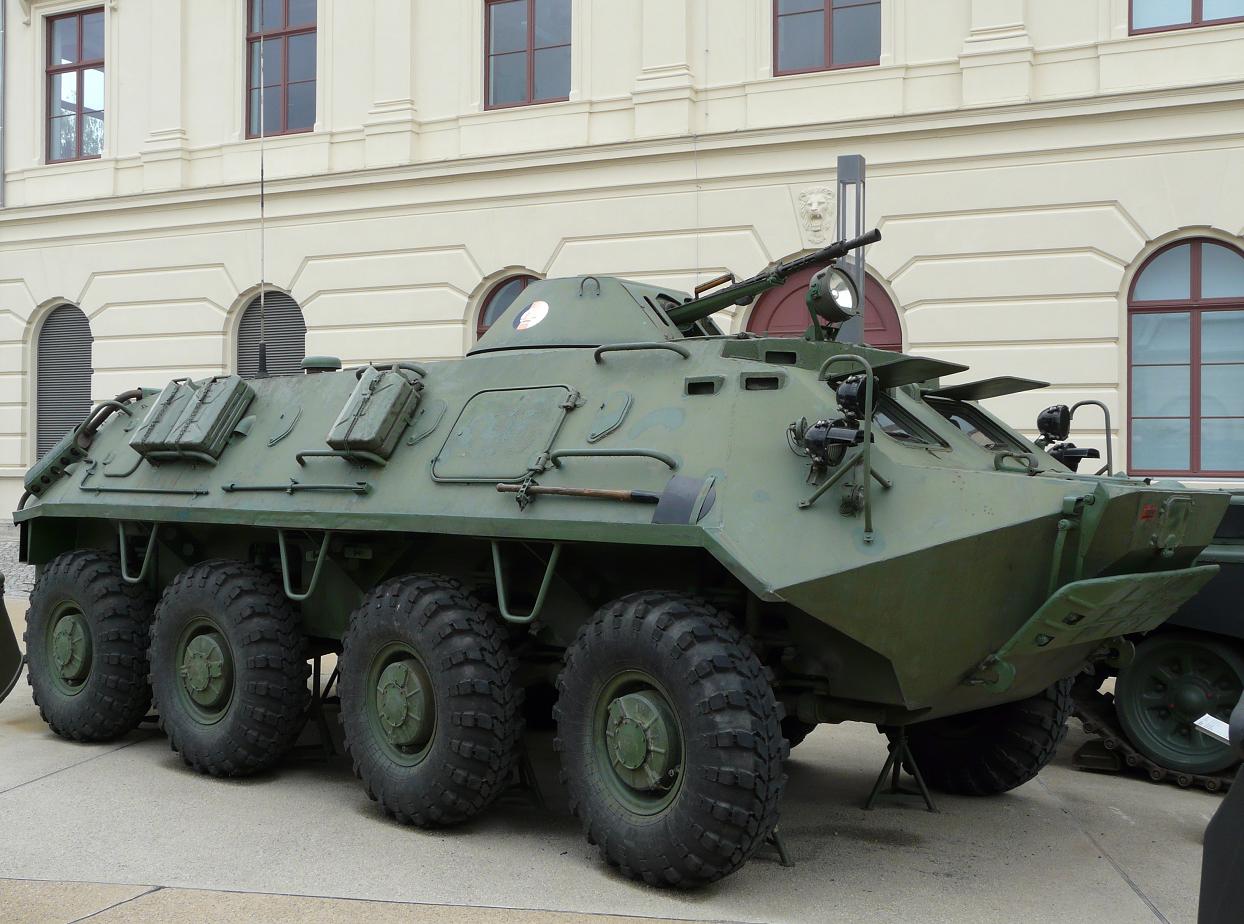
BTR-70

BTR-80

BTR-90

abs
Antigos, nada seguros, gastadores, inadequados, mas ainda muito queridos e absolutamente necessários e úteis nas guerras fraticídas do oriente médio e África. E assim como os veículos da série BMP, inegavelmente uma máquina de fazer dinheiro para os russos.
BTR-60
BTR-70

BTR-80

BTR-90

abs
Carpe Diem
- cabeça de martelo
- Sênior

- Mensagens: 39448
- Registrado em: Sex Out 21, 2005 10:45 am
- Localização: Portugal
- Agradeceu: 1136 vezes
- Agradeceram: 2843 vezes
Re: tanques e blindados
Manutenção da Viatura Blindada de Rodas (VBR) PANDUR II 8X8.
Integram parte do conteúdo programático desta formação os Cursos de Manutenção Nível I e II das VBR PANDUR II 8x8, versão Infantry Combat Vehicle.
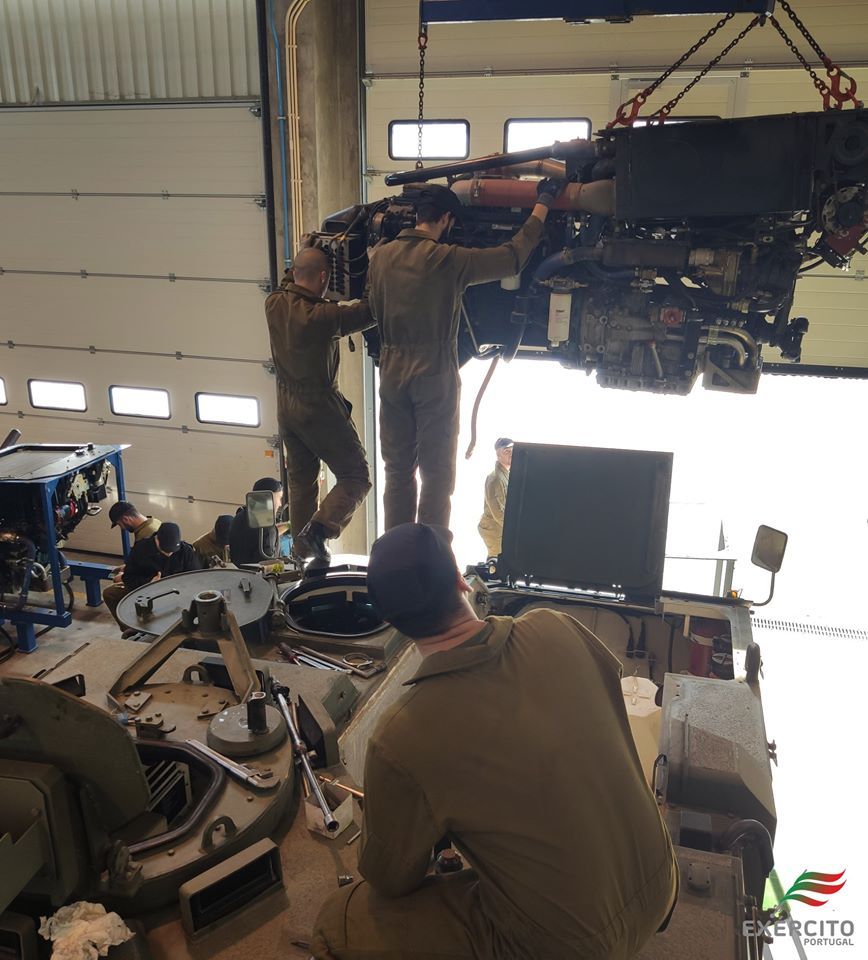
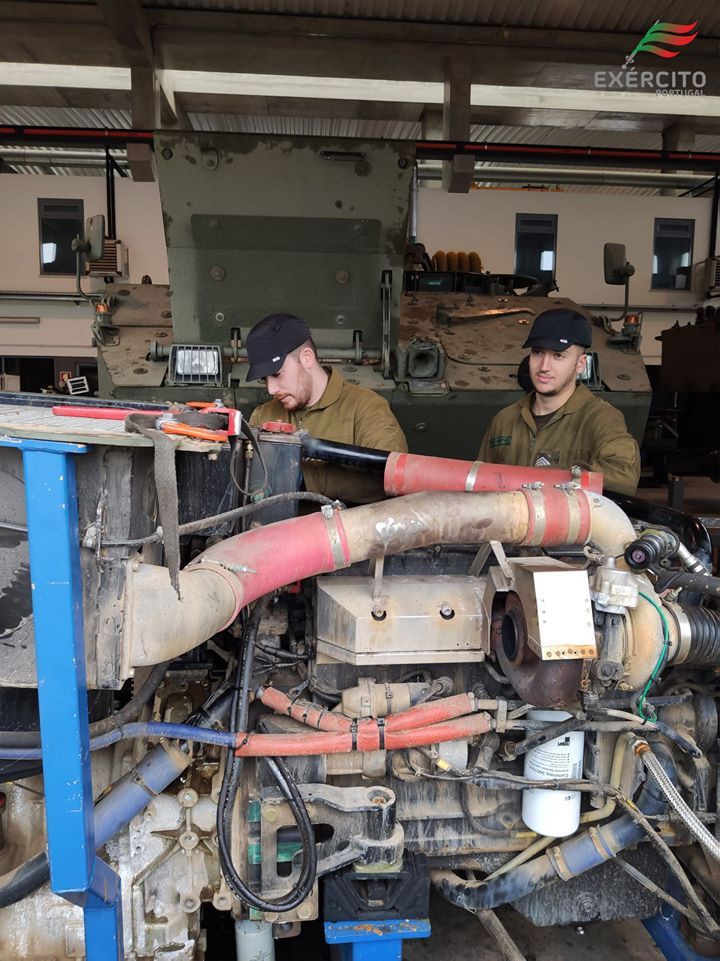




https://www.facebook.com/ExercitoPortug ... =3&theater
Integram parte do conteúdo programático desta formação os Cursos de Manutenção Nível I e II das VBR PANDUR II 8x8, versão Infantry Combat Vehicle.






https://www.facebook.com/ExercitoPortug ... =3&theater
- cabeça de martelo
- Sênior

- Mensagens: 39448
- Registrado em: Sex Out 21, 2005 10:45 am
- Localização: Portugal
- Agradeceu: 1136 vezes
- Agradeceram: 2843 vezes
- FCarvalho
- Sênior

- Mensagens: 37877
- Registrado em: Sex Mai 02, 2003 6:55 pm
- Localização: Manaus
- Agradeceu: 5704 vezes
- Agradeceram: 3255 vezes
Re: tanques e blindados
Embora no vídeo pareça até fácil fazer o que foi mostrado, a realidade se mostra bem diferente. Conquanto, a realidade dos UAV também já chegou as operações de cavalaria, tanto mecanizada quanto blindadas. E são parte indistinguível delas agora.
Muitas empresas tem lançados nos últimos anos várias versões de seus próprios UAV para equipar blindados e forças mecanizadas. O que temo se saber agora é quanto tempo vamos levar para também entrarmos nesse novo cenário.
Por enquanto, aqui o maior avanço da cavalaria depois de começar a substituir os Urutu pelos Guarani há quase dez anos atrás, foi colocar uma SARC .50 nele.
Mas um dia a gente chega lá.
abs
Muitas empresas tem lançados nos últimos anos várias versões de seus próprios UAV para equipar blindados e forças mecanizadas. O que temo se saber agora é quanto tempo vamos levar para também entrarmos nesse novo cenário.
Por enquanto, aqui o maior avanço da cavalaria depois de começar a substituir os Urutu pelos Guarani há quase dez anos atrás, foi colocar uma SARC .50 nele.
Mas um dia a gente chega lá.
abs
Carpe Diem
- EDSON
- Sênior

- Mensagens: 7303
- Registrado em: Sex Fev 16, 2007 4:12 pm
- Localização: CURITIBA/PR
- Agradeceu: 65 vezes
- Agradeceram: 335 vezes
Re: tanques e blindados
MAIN BATTLE TANK DEVELOPMENT CONCEPT OF GERMAN ARMY (PART 2)
Leopard II battle tank is pictured in action at the Oberlausitz training area in Weisskeissel.
Written by V. Boryushin, V. Sokolenko; Originally appeared at Foreign Military Review #3 2019, translated by AlexD exclusively for SouthFront
In the first part of the article the main directions of development of Germany’s CVA in the near future, the course of measures on modernisation of the existing park of tanks of the country, the concept of the MBT development and information on the creation of the Leopard tank of the prospective 2A8 (2A7V) series were covered.
The main battle tank is the Leopard-3. The creation of a new generation of MBT of Germany’s military-industrial leadership is associated with the development of the Leopard-3 tank, or Leo 3, as it was originally called in the Bundeswehr. Currently, foreign experts also use the term “Main Ground Combat System”.
In NATO countries, the ground combat system (GCS) is understood as a set of samples (complexes) of weapons that are functionally related to each other and are jointly used to solve certain combat tasks.
The GCS usually consists of 10 to 18 types of armoured vehicles operated by a person. These include tank, AIFVs, APCs; command vehicles of the company-battalion-brigade link; combat reconnaissance vehicle; self-propelled gun howitzer; self-propelled mortar; repair and evacuation vehicle; medical vehicle and others; from four to seven types of unmanned vehicles, remotely controlled by humans as well as unmanned aerial vehicles of different classes and purposes, armed with ground-based unmanned vehicles, multi-purpose general-purpose vehicles for technical and logistics support.
The German Ministry of Defence first announced plans to create a new-generation main battle tank as part of the GCS programme on May 22, 2015. For its development, the leading German manufacturer of armoured vehicles, KMW, intends to join forces with the famous French tank-building company Nexter Systems.
A new German-French company with more than 6,000 employees and a total financial turnover of about 2 billion euros ($2.2 billion for 2015) may become the main contractor able to win a contract for the development and production of the MBT for the Bundeswehr, France and other countries of the Alliance.
To date, the technical appearance and design features of the promising tank are in the design stage. Speaking in the Bundestag, German Deputy Defence Minister Markus Grübel said that “the concept of the new tank and the main technologies for its creation are planned to be developed in the period from 2015 to 2018. The issues of joint R&D with the German industry have already been agreed upon.”
The commander of the German Armed Forces, Lieutenant General Joerg Vollmer, noted in early 2017 that “all Leopard-2 tanks currently in tank and motorised infantry brigades will be completely replaced with the main GCS in the period from 2030 to 2040”. This system will be able to “conduct dueling combat and deliver fire strikes in close combat within a line of sight”.
From foreign information, it follows that the priorities in the development of the German-French machine will be given to ensuring the maximum survival of the crew in combat, giving the MBT maximum combat effectiveness in various types of combat, and achieving a low cost of production.
When developing the new tank, innovative technologies will be used to ensure the ability to conduct network-centric combat operations in the information networks of the tactical level of the types and branches of the armed forces of Germany and other NATO countries.
The firepower and mobility of the MBT is planned to increase considerably compared to existing models.
Conceptual views on the design and layout schemes of the Leopard-3 tank. The technical projects of the new generation tanks created earlier in Germany make it possible to form the following idea about the technical appearance and design layout of the new combat vehicle.
Project of the 1981-1996 years. This German-French tank had the following structural and technical features: a crew of three people (two of them, the commander and the gunner, in a flat low-profile turret); a 120-mm and in the future, 140-mm smoothbore gun; automatic gun loading in the niche of the turret; an automated system for loading and unloading ammunition on the battlefield from a transport-loading vehicle; the chassis of the Leopard-2 tank.
However, consensus could not be reached between the participating countries, and in November 1982 France withdrew from the R&D. After that, the German part of the project was named Leopard-3. Research was carried out in the following areas: development of a new turret on the chassis of the Leopard-2 tank, a new low-profile non-armoured turret and new chassis. However, this programme was terminated due to the lack of relevance of the work carried out at that time, and the emergence of priority R&D aimed at increasing the caliber of tank guns.
Project of the 1985-1996 years. This is one of the first MBT projects of a new generation with two crew members.
The western military media previously reported that a demonstration model had already been developed, testing of which showed that “with the technical level of automation of work processes, which is typical for that time, a crew of two people can perform all the tasks assigned to it as successfully as a crew of three or four people”.
With this in mind, KMW began to develop a concept for the overall protection of an experimental tank with a 140-mm gun (with a non-armoured, remote-controlled turret) and two crew members located in the front of the hull. The experimental prototype was named EGS.
The layout of its hull was similar to the tank test-bench of the TTV, created in the US by GDLS in the early 1980s on the order of the command of the United States Army Tank-Automotive and Armaments Command (TACOM). However, the American version of the experimental tank had a crew of three and demonstrated the advantages of placing all crew members in the hull, although its critical frontal zone (which protects the crew) was only 2.77 m2 compared to 3.59 m2 for the M1 Abrams tank, on the chassis of which the TTV test-bench was created.
The critical frontal zone of the EGS tank was even smaller, which made it possible to cover it with armour of greater thickness without increasing the mass of the vehicle.
This layout principle clearly proved the advantages of such a design and layout solution, as it allowed to have a frontal armour equivalent to rolled homogeneous armour with a thickness of more than 1,000 mm. In addition, placing the crew inside the tank body outside the turret increased its survival rate. Despite the significant improvement in the protection of the tank with a two-man crew, many military experts rated this variant of the layout negatively due to the inability of two people to effectively control the tank in combat for a long time (more than 4 hours).
In addition, R&D results have shown that it is necessary to recognise the limited endurance of a two-person crew when driving a tank in combat for a long time.
It was suggested that two crews should be prepared for each tank, which could replace each other in the course of long-term combat operations. However, the military leadership in Germany and officers with combat experience expressed their doubts about the possibility of successfully replacing the crews in a combat situation.
Project of the 1996-1998 years. Here, the promising machine was considered as a tank of the XXI century, which was planned to introduce the following technical innovations: a smooth-bore 140-mm gun that fires separate loading ammunition; an automatic loader in the turret recess; a compact fighting compartment with two crew members; an electric transmission; as well as carry out a set of measures to strengthen the overall protection, especially in the frontal plane; measures to reduce infrared and radar visibility; active protection system; advanced fire control system of the new generation; digital architecture of the on-board information system of the open type.
The new layout of the tank with a crew of two people focused on the use of new technologies, allowed to protect the frontal projection of the vehicle with armour with an equivalent thickness of rolled homogeneous armour equal to 2000 mm. The project remained unrealized, because at first there were problems with coordinating tactical and technical requirements with the industry, and later, due to the changed military and political situation in the world and insufficient funding.
Conducting a full-scale R&D in the current environment was considered irrelevant and untimely.
Project of the 1996-2004 years. It was developed under a programme called NGP (New Armoured Platforms). This was the first German programme, according to which it was planned to create machines for the benefit of the land forces, a ground combat system. When developing the project, for the first time in foreign practice, it was planned to implement the principle of using a common unified 50-ton tracked chassis as a single base for three types of vehicles (tank, AIFV, APC). It was supposed to create three types of unified platforms: type A – the main battle tank, initially with a 120-mm, and later with a 140-mm gun; type B – a highly protected AIFV; type C – a heavy tracked general purpose armoured personnel carrier for transporting infantry.
The arrival of the type A platforms in the army was to begin after 2012, taking into account that the service life of the Leopard-2A5 tank expired in 2015, and serial production of the types B and C platforms was planned to begin in 2009, in order to timely replace the fleet of tracked Marder ARV and wheeled (6 x 6) Fuks APCs.
The main goal of the NGP programme was to reduce the number of tank crew members from four to three or two.
In studies conducted in Germany in collaboration with KMW, the effectiveness of the combat work of the tank crew of two people was evaluated, provided that the crew was replaced every 12 hours, so that the tank could be operated without interruptions for several days. The NGP programme was closed in 2004 due to the high complexity and cost of work, and mainly due to the change of priorities of the German ground forces command in favour of the development of the Puma BMP (R&D began in 2002) and the programme for the creation of the boxer armoured personnel carrier (in 1999). The NGP programme ended with the creation of a demonstration chassis layout for a promising tank.
Project of the 2001-2005 years. It was developed by the German firm KMW proactively based on the conceptual provisions of the project as outlined in the report “Alternative Weapons for Combat Platforms of the Future”, made by the KMW representative. In this document, when justifying the main directions of weapons development, and in particular the new generation of MBTs, it was argued that the disadvantages of modern concepts that determine the firepower of combat vehicles are the following: the tank’s rocket and gun armament cannot be used simultaneously for different ground and air targets; it is impossible to control these weapons by “direct calls” from the infantry and other attached units, or it takes too much time, which increases the time spent on hitting the target, and does not provide the required flexibility in using the tank’s weapons system.
The key element of the new weapons system should be, according to German experts, the use of vertically launched missiles with the control of the “shot-forgot” type. Such missiles can be used to destroy unmanned aerial vehicles (UAVs), helicopter gunships, or used against a wide range of ground targets (tank units on the march and in areas where they are concentrated, against command posts and other important near facilities, and others).
It was planned to install eight to ten guided missiles in the launch containers in a vertical position, which could be launched in any direction, at any time, regardless of whether the gun is fired or not.
In accordance with the project, the new MBT should have a crew of three: two operators sitting side by side in the front of the hull (the operator, gunner and the operator-commander of the machine), and a driver. It was planned that the tank would be armed with a 140-mm gun (with an ammunition supply of 30-32 rounds) and vertically launched guided missiles located in the niche of the turret. The concept of the tank’s weaponry was first developed in the framework of the NGP.
Conceptual views of the main directions of development of combat properties of the Leopard-3 tank.
Fire power. German experts believe that the creation of a new generation of MBTs will be closely connected with the increase in the caliber of the tank gun, so the development of tank weapons and ammunition should become a priority in the near future. At the same time, it is emphasized that the upper limit of the tank gun caliber has not yet been reached and can be increased to 140- 155-mm due to design and layout solutions, although expensive and complicated.
As noted in the materials published in the western military media, the increase in caliber is necessary in order to guarantee that heavy armoured combat vehicles can be hit from a long distance. At the same time, foreign sources indicate that the effectiveness of modern tank ammunition has already reached the maximum value, when 120-mm armour-piercing sub-caliber projectile (APS) and cumulative projectiles (CP) no longer provide the armour-piercing characteristics that promising tank guns above the specified caliber can provide.
At the same time, the experience of installing a 140-mm gun in a tank has shown that there are many complex technical problems along this path that cannot be solved quickly by modern scientific and technical methods. The main one is the development of automatic loading guns with unitary 140-mm ammunition.
The transition to separate charging for many reasons is recognised by German experts as impractical for the following reasons: it is impossible to maintain the tank’s internal dimensions of ammunition within 40-45 units (while reducing the 140-mm ammunition to 28-30 pieces is considered unacceptable from a tactical point of view), as well as due to the need to install a partially or fully automated ammunition loading/unloading system in the tank. The development of such a system requires the creation of special transport loading tracked vehicles, making significant changes to the existing design of the body and especially the machine’s turret. In general, the solution to these problems, according to foreign experts, is associated with time-consuming and expensive measures, which in terms of their costs and complexity of R&D is comparable to the creation of a new tank.
Under these conditions, military experts of the leading NATO countries recognise that the current military and political situation in the world and the limited military budgets of Alliance members for the development and purchase of new tanks will not allow even in the medium term (within 10-15 years) to replace the 120-mm guns with 140-mm ones.
Work priority areas on the 140-mm gun remain: the creation of a loading machine, the development of new ammunition, the creation of a system for automated loading of ammunition into a tank from a transport-loading machine. The final decision to start mass production is delayed today due to insufficient funds allocated for the development, refinement and production of the required number of such ammunition.
Another limiting factor in the development of the gun is the high efficiency of innovative technologies introduced to further improve the characteristics of the 120-mm gun, ammunition and the tank’s weapons control system (WCS).
Currently, German experts believe that the progress made in the development of modern technologies in the field of tank guns, ammunition and fire control systems makes it possible to achieve a level of performance of the 105-mm tank guns close to the characteristics of the 120-mm guns of the first generation, and the new generation of 120-mm tank guns is comparable to the characteristics of 130-mm guns.
The existing successes in the development and implementation of innovative technologies for improving the 120-mm gun, its ammunition, and the WCS forced German specialists to reconsider their views on the further development of tank weapons, which was due to technical difficulties in solving scientific problems associated with the installation of large-caliber guns in the MBT.
For these reasons, Rheinmetall specialists became confident in the early 2010s that the characteristics of a 140-mm gun could be achieved by creating a 130-mm gun, provided that its technical level, ammunition, and WCS were brought to a certain level of perfection.
As a result, in the long term (over 15-30 years), it will be possible to limit the increase in the caliber of the tank gun to 130-mm. In this case, a number of scientific and technical problems associated with increasing the caliber of tank guns to 140-mm can be solved at a lower cost, cheaper and technically in a less complex ways.
The 130-mm smoothbore tank gun created by Reinmetall was shown to the general public for the first time in June 2016 at the Eurosatory arms exhibition in Paris. The gun differed from the 120-mm serial prototype in having a shorter barrel length (51 calibers instead of 55), a vertical-falling wedge bolt, an increased chamber volume and a chrome-plated bore surface.
Its mass, including anti-rollback devices, was about 3000 kg, the barrel weight was 1400, while the muzzle brake was not provided and was absent.
The prototype shown at the exhibition had an ejector, a heat-insulating gun barrel casing and a system for automatic alignment of the sight during thermal bending of the barrel. As reported in the advertising and technical brochures of the company, the gun is intended for installation on a new-generation Leopard-3 tank, as well as the MBT Leopard-2 series during their modernisation.
It was stated that at the current development stage of the 130-mm tank gun, two types of unitary ammunition should be considered as priority areas of work: armour-piercing sub-caliber feathered projectile with detachable leading parts, which will have a partially combustible sleeve, an increased volume and improved physical and chemical composition of the propellant, an elongated, compared to the 120-mm APS, tungsten core; a high-explosive air-detonating projectile that is being developed on the basis of the 120-mm DM11 munition currently in production for the domestic and foreign markets and used for firing 120-mm L44 and L55 tank gun.
During the development of the 130-mm ammunition, one of the most important areas was to reduce the explosion and fire safety of ammunition when it is used in a tank, including in the case of armour pentation, which is the main requirement of most modern customers of this ammunition.
Western military experts believe that the 130-, 140-mm smoothbore gun will be used as the main armament of the next-generation tank, and it will be possible to fire guided ammunition. Observation of the environment from the tank will be carried out using a system of electronic sensors (implementation of the principle of “observation through the armour”). The following types of unitary ammunition are under development: an armour-piercing feathered projectile with detachable launch charges and a high-explosive air-detonating projectile.
The plan is to fire the cannon from the driver’s seat.
For the main battle tank of the new generation, military customers make demands to ensure full-fledged circular protection of the vehicle from most current and future threats.
Protection. Military customers make demands to ensure all-round protection of the tank against most current and future threats, especially when attacking the upper hemisphere. For this purpose, it is planned to use modular armour protection developed on the basis of nanotechnologies (nanosteel and nanocomposite materials), so that the increase in the combat weight of the tank is relatively small. Among other requirements, the following are highlighted: ease of installing additional armour protection on the outside of the tank, as well as minor changes to the design of the vehicle’s hull and turret when installing armour modules.
The basic version of the modular armour system needs to protect the crew from high caliber shotgun, precision guided munitions and guided and unguided antitank weapons, the roof of the hull and turret from cluster munitions, side protection of the hull and turret from mines and IEDs, including fragments of 155-mm caliber artillery shells and the protection of the lower part of the hull from mines and IEDs.
Other requirements are also known: the firing pad must be located outside the combat compartment zone, the system for setting a circular smoke (aerosol) curtain must be triggered after detecting a threat in the visible, thermal, television and radar waves ranges for a period not exceeding 0.5 seconds. It must also be operable in motion.
Mobility. A number of measures aimed at improving the mobility in various tank’s combat application are planned, including controlling the movement of the vehicle from the commander’s and gunner’s workstations, short-term increase in power on the drive wheels, insuring for a short time silent and emergency movement when the main engine is idle. These modes of operation of the power unit is planned to be realised by connecting the main motor of the auxiliary power plant of increased power, as well as electrical and mechanical (inertial type) energy storage devices.
Command controllability. It is planned to increase by about 2-3 times the amount of electrical power generated on board the tank to supply the increased number of on-board electronic systems by using more powerful auxiliary power units. The levels of automation and “intellectualisation” of combat and work processes that take place during firing and in motion will be significantly increased to ensure survivability and command control.
All tanks will be equipped with standard remote-control equipment, which will, if necessary, enable the crew-free operation of the combat vehicle.
Thus, the further development of the main battle tank in Germany is carried out at the present stage in two separate directions: the modernisation of the Loepard-2 tank series to the A8 modification and the creation of a new generation of MBT Leopard-3. According to the first direction, using modern technologies, the design of the Leopard-2 tank is planned to be brought to the maximum level of perfection, including by creating and installing a next-generation tank gun on it.
- EDSON
- Sênior

- Mensagens: 7303
- Registrado em: Sex Fev 16, 2007 4:12 pm
- Localização: CURITIBA/PR
- Agradeceu: 65 vezes
- Agradeceram: 335 vezes
Re: tanques e blindados
A BTR 82 A aguentou um impacto de uma carro bomba, lembrando que este BTR possui melhor blindagem que seu antecessor BTR 82. Nenhum tripulante morreu e apenas três ficaram levemente feridos.






- FCarvalho
- Sênior

- Mensagens: 37877
- Registrado em: Sex Mai 02, 2003 6:55 pm
- Localização: Manaus
- Agradeceu: 5704 vezes
- Agradeceram: 3255 vezes
Re: tanques e blindados
Estranho. Era um bldo da polícia do exército russo. Estava parado na beira da estrada tomando uma sombra e do nada um carro bomba explode bem ao lado dele.
Ninguém viu o carro chegando. O que os tripulantes estavam fazendo?
Com aquele canhão ali em cima e outros sistemas de observação como um veículo poderia chegar tão perto a tempo de atacar o bldo sem nenhuma reação aparente da tripulação.
Muito boa sorte a deles. Ficou só um "buraquinho" e uns arranhões na lataria. Um bom lanterneiro resolve.
abs
Ninguém viu o carro chegando. O que os tripulantes estavam fazendo?
Com aquele canhão ali em cima e outros sistemas de observação como um veículo poderia chegar tão perto a tempo de atacar o bldo sem nenhuma reação aparente da tripulação.
Muito boa sorte a deles. Ficou só um "buraquinho" e uns arranhões na lataria. Um bom lanterneiro resolve.
abs
Carpe Diem
- EDSON
- Sênior

- Mensagens: 7303
- Registrado em: Sex Fev 16, 2007 4:12 pm
- Localização: CURITIBA/PR
- Agradeceu: 65 vezes
- Agradeceram: 335 vezes
Re: tanques e blindados
Veja o vídeo você não assistiu? Os blindados russos e turcos estavam em ptrm.FCarvalho escreveu: ↑Qui Jul 16, 2020 1:11 am Estranho. Era um bldo da polícia do exército russo. Estava parado na beira da estrada tomando uma sombra e do nada um carro bomba explode bem ao lado dele.
Ninguém viu o carro chegando. O que os tripulantes estavam fazendo?
Com aquele canhão ali em cima e outros sistemas de observação como um veículo poderia chegar tão perto a tempo de atacar o bldo sem nenhuma reação aparente da tripulação.
Muito boa sorte a deles. Ficou só um "buraquinho" e uns arranhões na lataria. Um bom lanterneiro resolve.
abs


- FCarvalho
- Sênior

- Mensagens: 37877
- Registrado em: Sex Mai 02, 2003 6:55 pm
- Localização: Manaus
- Agradeceu: 5704 vezes
- Agradeceram: 3255 vezes
Re: tanques e blindados
Há tá, agora sim. Por este ângulo deu para ver melhor. O outro vídeo não notei o bldo russo aparecendo, somente a explosão.
Ficou bem claro agora. Valeu.
Deu para ver também, olhando novamente o vídeo anterior e mais esse que os veículos andavam bem afastados uns dos outros. Talvez para diminuir os efeitos colaterais justamente de ataques como esses.
Eles não tem nenhum tipo de procedimento de segurança quanto ao trânsito nas estradas onde trafegam para evitar, ou dirimir, esse tipo de ataques?
Fosse aquele blindado turco ou um Tigre da MP russa, e talvez o pessoal não tivesse tido a mesma sorte.
abs
Ficou bem claro agora. Valeu.
Deu para ver também, olhando novamente o vídeo anterior e mais esse que os veículos andavam bem afastados uns dos outros. Talvez para diminuir os efeitos colaterais justamente de ataques como esses.
Eles não tem nenhum tipo de procedimento de segurança quanto ao trânsito nas estradas onde trafegam para evitar, ou dirimir, esse tipo de ataques?
Fosse aquele blindado turco ou um Tigre da MP russa, e talvez o pessoal não tivesse tido a mesma sorte.
abs
Carpe Diem
